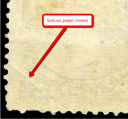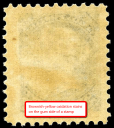
The rare stamps section of Arpin Philately is extremely popular. Collectors regularly keep an eye on it, on the lookout for little gems to add to their collection. Our rare stamp section also offers rarer stamps with slight faults or flaws in them which significantly lower their cost, enabling you to fill holes in your album for older stamps that otherwise you might not be able to afford.
Here is a glossary of the stamp terms most often used to describe the condition of rare stamps, which you may or may not be familiar with. Obviously, the presence of one or more of these conditions affects the value of a stamp. The stamps in our “Rare Stamp” section have been priced accordingly.
Albino: an uninked impression made by a printing plate. Such errors are scarce on stamps. They are more often found on postal stationery.
Bend: very slight impression or wrinkle in the stamp paper, usually caused by the paper shrinking, but not the gum, resulting in a minor contraction of the paper.

Crease: a very noticeable fold in the stamp paper. A crease will show up as a dark line on the back of the stamp when the stamp is soaked in watermark detector fluid.
Cut: a cut in the stamp paper, usually made by scissors
Foxing (or sometimes also called “rusting”): a discolouration on the stamp which looks like reddish-brown spots. It is caused by a fungus that thrives in humid, tropical climates, or in humid storage conditions.
Major re-entry: a re-entry looks like a doubling, or sometimes, tripling of the lines of a stamp design. It happens when the transfer roll has to be reapplied to the original stamp plate in order to freshen up or sharpen the worn design. If the transfer roll was misaligned during the process, an obvious doubling of some, or all, parts of the design will appear in the new pressing. “Major” re-entry is self-explanatory.

Nibbled perf: some shorter perforations along the stamp edges, not to be confused with missing perfs.

Oxidation: brown or black darkening, usually caused by contact with light, air or certain fumes
Rebacked: when a thin piece of paper is affixed to the back of a stamp in order to camouflage serious thinning. Afterwards, the stamp often seems stiffer than normal.
Regummed: when adhesive has been applied to the back of a stamp that is missing some, or all, of its original gum.
Repair: when a damaged stamp has been fixed in order to appear in better condition than it actually is.
Tear: pretty much self-explanatory. A tear appears as a raggy, irregular split in the stamp, as opposed to a cut.
Thin: when part of the paper in missing from the back of a stamp, usually caused by forcefully removing a hinge. A thin can spread over a large area of the back of the stamp, or be as small as a pinhead. It can be detected by holding the stamp up to a bright light, or by dipping it in watermark detector fluid. In front of the light the thin will appear lighter than its surroundings, in the watermark fluid the thin will appear darker.
Toning: a yellowing or darkening of the colour of a stamp due to exposure to sun or acidic paper.